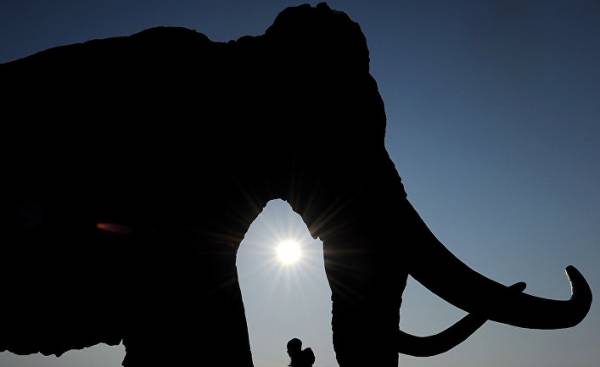
Due to a genetic depletion, the last of a species died a lonely death, languishing among the tundra on a windswept island, unable to attract a partner by the smell of his urine.
Mainland mammoths once common in North America and Siberia are extinct as a species as the result of climate warming and active human hunting about 10 thousand years ago. More scattered small populations living on Islands where no predators lived, lasted six thousand years. However, as a new study shows that the last living mammoths on Earth were waiting for a rather strange evolutionary junction she can serve as a guide to employees on the protection of nature, which send their forces to rescue declining species, and those who want to bring back the mammoths themselves.
In a new paper published on Thursday in PLoS Genetics, compared the genomes of two woolly mammoths excavated: one from the mainland of Siberia, who lived 45 thousand years ago and another age of 4300 years from the deserted Wrangel island, which is a lump about the size of Delaware to the North of Siberia — the last known refuge of mammoths. The authors reported that the last of the mammoths before his disappearance was subjected to “genetic degradation”, that is, their genomes have been depleted by harmful mutations that were not good for them nor socially nor sexually.
Two mutations of this kind gave their famous shaggy wool fancy satin translucency; other mutations weakened sense of smell and caused irritation of the stomach; and a number of genetic abnormalities has hampered production in the urine protein, which scientists already know — thanks to research Indian elephant, the closest living relatives of mammoths planet — in the family of ivory is able to establish or break the courtship of potential partners (as well as to assert their social class).
New data confirm the mathematical model, the theory suggests that decreasing the size of any population of animals, it can be prone to genomic degradation; natural selection loses its effectiveness, and harmful mutations which usually weeds out, eventually leaving just because of genetic variants from which to choose, not so much. “This study is extremely interesting because it allows us to look at the “before” and “after” changes in the number of populations within the same species, says study co-author, Professor of bioinformatics and genomics University of North Carolina (Charlotte) Rebecca Rogers (Rebekah Rogers). — The mammoths from Wrangel island, we observe a significant excess of so-called deleterious mutations. To find the population in the process of extinction is difficult, but this study finally made it possible thanks to advances in DNA sequencing”.
Rogers admits that she and her co-author Montgomery Slatkin (Montgomery Slatkin) — famous biologist at the University of California (Berkeley), long time studying the genomics of population sizes — not sure whether deleterious mutations have become the direct reason for the extinction of mammoths. However, it considers that the latter did not contribute to adaptation increasingly isolated megafauna to changing environment.
New data can have sobering consequences for the organizers of environmental activities. The salvation of a small isolated community, one of the endangered species can facilitate the spread of unfavorable genes, which are the result of inbreeding and the genomic decline, the numerical view will be updated, but already affected by the disease. Biologist at the Swedish Museum of natural history Love Dalen (Love Dalén), which was not directly involved in the study of Rogers and Slatkin, adds: “the fact that the probability of genomic deletions increases in a shrinking population is, in General, overlooked by biologists from the field of nature protection. If this pattern is observed in other species, this pattern represents an additional risk to the genetic health of species under threat of extinction”.
Rogers explains that the longer a population remains small, the more potentially harmful mutations it may have to purchase — and even if the view is restored to a sufficient size, its collective genome will continue to carry traces of mutational decay. Although, she adds, on the basis of mathematical modelling there are assumptions that mammoths from Wrangel island your accumulating harmful mutations over many hundreds of generations. Given that a large number of species fell into the endangered list recently, maybe there’s still hope that some of them can be saved without any damage to their genomes.
Rogers hastened to admit that the results of their research owes much to Dalen, who first conducted the sequencing used in the new study of mammoths in 2015 unveiled their genomic sequence. Dalen has also provided its data to other biological research — an ambitious and ethically ambiguous project whose name speaks for itself: the revival of the woolly mammoths.
Often mentioned in the news, these joint efforts of the team led by geneticist from Harvard George Church (George Church) aims to use genetic engineering methods to bring back the mammoth, more precisely, to produce more like the mammoth elephant and populate remote areas of the Earth; in other words, to reverse the extinction reversed. While the research team successfully uses the technology of gene editing CRISPR-Cas to splice the genes of a mammoth with living cells of an elephant, Church hopes to attempt cloning in 2018 (where some experiment is already waiting for a surrogate mother elephant or perhaps an artificial uterus).
Even if we leave aside the question of whether people return to life of the mammoth, the new data represent a new challenge that can stop us on the way of revival of a sick animal. “In regard to the return of the extinct mammoths, I am most worried about the ethical implications, worries Rogers. — Elephants are extremely intelligent and social animals. They are able to suffer as we do. If their DNA gets harmful mutation, the consequences for the quality of life elephants can be very serious.” Therefore, with great respect and admiration referring to the Drawing and his work, she was confident that this group of scientists will take care to avoid any damage to DNA.
Dalen agrees that in any further steps for the revival of extinct species should take into account new data since the introduction of genes of animal to “near extinction” may lead to serious health problems. “I don’t know whether [the Church group] to use the genome of mammoths from Wrangel island, he jokes. But if you do so, they can expect surprises like smooth wool and irritation of the stomach”.







